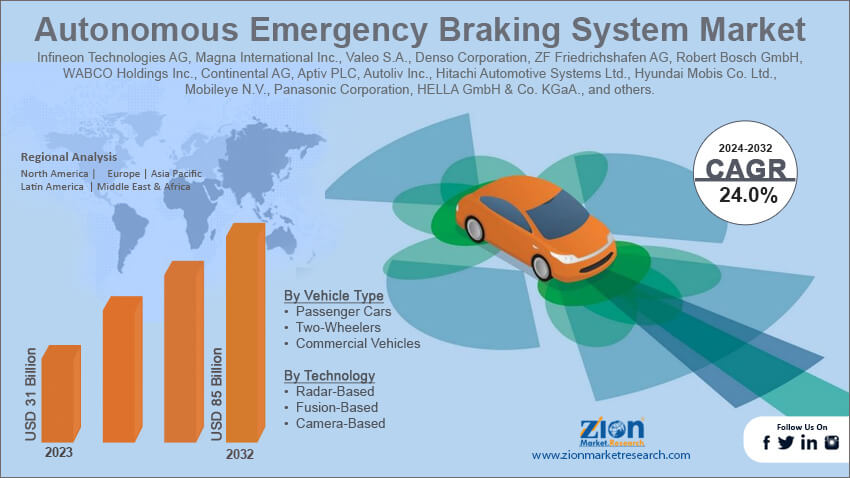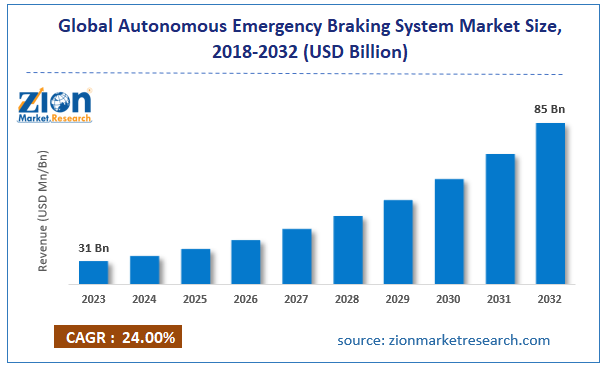Autonomous Emergency Braking System Market Size, Share, Trends, Growth 2032

Autonomous Emergency Braking System Market By Vehicle Type (Passenger Cars, Two-Wheelers, and Commercial Vehicles), By Technology (Radar-Based, Fusion-Based, and Camera-Based), and By Region - Global and Regional Industry Overview, Market Intelligence, Comprehensive Analysis, Historical Data, and Forecasts 2024 - 2032-
| Market Size in 2023 | Market Forecast in 2032 | CAGR (in %) | Base Year |
|---|---|---|---|
| USD 31 Billion | USD 85 Billion | 24% | 2023 |
Autonomous Emergency Braking System Industry Prospective:
The global autonomous emergency braking system market size was evaluated at $31 billion in 2023 and is slated to hit $85 billion by the end of 2032 with a CAGR of nearly 24% between 2024 and 2032.
Autonomous Emergency Braking System Market: Overview
An autonomous emergency braking system is an advanced safety feature designed to prevent accidents by automatically applying the brakes before a potential crash is detected. It uses sensors, including cameras and radars, to detect potential hazards. Reportedly, the system is a main component of advanced driver assistance systems and ensures road safety.
Key Insights
- As per the analysis shared by our research analyst, the global autonomous emergency braking system market is projected to expand annually at the annual growth rate of around 24% over the forecast timespan (2024-2032)
- In terms of revenue, the global autonomous emergency braking system market size was evaluated at nearly $31 billion in 2023 and is expected to reach $85 billion by 2032.
- The global autonomous emergency braking system market is anticipated to grow rapidly over the forecast timespan, as governments across the globe are mandating the need for integrating new safety features such as autonomous emergency braking systems in passenger cars and commercial vehicles.
- In terms of vehicle type, the passenger cars segment is slated to register the highest CAGR over the forecast period.
- Based on technology, the fusion-based segment is predicted to contribute majorly towards segmental space in the upcoming years.
- Region-wise, the Asia-Pacific autonomous emergency braking system industry is projected to register the fastest CAGR during the projected timespan.
 Request Free Sample
Request Free Sample
Autonomous Emergency Braking System Market: Growth Factors
A surge in self-driven vehicles will propel the expansion of the global market over forecast period
An increase in the sale of autonomous cars is expected to fuel the progress of the global autonomous emergency braking systems market. Moreover, governments across the globe are mandating the need for integrating new safety features, such as autonomous emergency braking systems in passenger cars and commercial vehicles, thereby steering the global market trends.
Supportive insurance plans for automotive are projected to aid the global market surge in the ensuing years. Technological breakthroughs and the use of AI will increase the size of the global market. Humungous use of advanced driver assistance systems will catapult the market expansion over the forecast period.
Autonomous Emergency Braking System Market: Restraints
An increase in the product repairing costs can restrain the cost of the industry globally over assessment period
A rise in the repair & maintenance charges, along with the need for initial investments in developing autonomous emergency braking systems, can restrict the global autonomous emergency braking systems industry. False alarms and unintended braking systems can also downgrade the expansion of the global industry.
Autonomous Emergency Braking System Market: Opportunities
Burgeoning demand for new safety features in vehicles can pave the way for immense expansion of the global market
Escalating need for advanced safety features and a rise in the sale of premium cars can open new growth avenues for the global autonomous emergency braking system market. Moreover, integrating of autonomous emergency braking systems with AI, IoT, and V2X communications will scale up the global market surge.
Autonomous Emergency Braking System Market: Challenges
Lack of availability of advanced sensor devices can degrade the global industry development in the forthcoming years
Growing cyber-security issues and compliance charges are projected to challenge the global autonomous emergency braking system industry. Moreover, the need for effective sensors, including cameras and radars, is likely to create hurdles in the growth path of the global industry.
Autonomous Emergency Braking System Market: Segmentation
The global autonomous emergency braking system market is divided into vehicle type, technology, and region.
In terms of vehicle type, the autonomous emergency braking system market across the globe is segmented into passenger cars, two-wheelers, and commercial vehicles segments. Apparently, the passenger cars segment, which amassed nearly 69% of the global market revenue in 2023, is anticipated to record the fastest CAGR in the upcoming years, subject to increasing passenger car production as well as sale of these cars globally.
Based on the technology, the global autonomous emergency braking system industry is segmented into radar-based, fusion-based, and camera-based segments. Apparently, the fusion-based segment, which dominated the global industry in 2023, is expected to contribute notably towards the segmental surge in the upcoming years. This can be owing to an immense demand for fusion-based technology that integrates radar & camera systems for offering more apt & reliable detection of objects as well as tracking.
Autonomous Emergency Braking System Market: Report Scope
| Report Attributes | Report Details |
|---|---|
| Report Name | Autonomous Emergency Braking System Market |
| Market Size in 2023 | USD 31 Billion |
| Market Forecast in 2032 | USD 85 Billion |
| Growth Rate | CAGR of 24% |
| Number of Pages | 221 |
| Key Companies Covered | Infineon Technologies AG, Magna International Inc., Valeo S.A., Denso Corporation, ZF Friedrichshafen AG, Robert Bosch GmbH, WABCO Holdings Inc., Continental AG, Aptiv PLC, Autoliv Inc., Hitachi Automotive Systems Ltd., Hyundai Mobis Co. Ltd., Mobileye N.V., Panasonic Corporation, HELLA GmbH & Co. KGaA., and others. |
| Segments Covered | By Vehicle Type, By Technology, and By Region |
| Regions Covered | North America, Europe, Asia Pacific (APAC), Latin America, Middle East, and Africa (MEA) |
| Base Year | 2023 |
| Historical Year | 2018 to 2022 |
| Forecast Year | 2024 - 2032 |
| Customization Scope | Avail customized purchase options to meet your exact research needs. Request For Customization |
Autonomous Emergency Braking System Market: Regional Insights
North America is likely to maintain leading status in the global market over the projected time-interval
North America, which contributed about 54% of the global autonomous emergency braking system market size in 2023, is likely to establish a leading position in the global market in the upcoming years. Apart from this, the regional market progression in the next couple of years can be ascribed to an escalating sale of vehicles and strict enforcement of laws by the government in North American countries mandating the use of autonomous emerging braking technologies in new vehicles.
Presence of key vehicle manufacturers in various states of the U.S. is likely to propel the market expansion in North America. On April 2024, the National Highway Traffic Safety Administration announced that all passenger cars & trucks sold in the U.S. in 2023 will be required to have autonomous emergency braking systems, including cameras & sensors, by 2029.
Asia-Pacific autonomous emergency braking system industry is likely to record the fastest compounded growth annually in the forecasting years. The elevation of the industry in the APAC zone can be a result of surging urbanization and the presence of giant automotive manufacturers in Japan, Malaysia, India, Thailand, Indonesia, and South Korea.
Government incentives and discounts over the use of autonomous emergency braking systems in vehicles and economies of scale in vehicle production have decreased vehicle costs, thereby exponentiating industry growth in the Asia-Pacific region.
Key Developments
- In April 2021, ZF Friedrichshafen AG introduced advanced autonomous emergency braking systems for Chinese commercial vehicles.
Autonomous Emergency Braking System Market: Competitive Space
The global autonomous emergency braking system market profiles key players such as:
- Infineon Technologies AG
- Magna International Inc.
- Valeo S.A.
- Denso Corporation
- ZF Friedrichshafen AG
- Robert Bosch GmbH
- WABCO Holdings Inc.
- Continental AG
- Aptiv PLC
- Autoliv Inc.
- Hitachi Automotive Systems Ltd.
- Hyundai Mobis Co. Ltd.
- Mobileye N.V.
- Panasonic Corporation
- HELLA GmbH & Co. KGaA.
The global autonomous emergency braking system market is segmented as follows:
By Vehicle Type
- Passenger Cars
- Two-Wheelers
- Commercial Vehicles
By Technology
- Radar-Based
- Fusion-Based
- Camera-Based
By Region
- North America
- The U.S.
- Canada
- Europe
- France
- The UK
- Spain
- Germany
- Italy
- Rest of Europe
- Asia Pacific
- China
- Japan
- India
- South Korea
- Southeast Asia
- Rest of Asia Pacific
- Latin America
- Brazil
- Mexico
- Rest of Latin America
- Middle East & Africa
- GCC
- South Africa
- Rest of Middle East & Africa
Table Of Content
Methodology
FrequentlyAsked Questions
An autonomous emergency braking system is an advanced safety feature designed to prevent accidents by automatically applying the brakes before a potential crash is detected.
The global autonomous emergency braking system market will grow over the forecast period due to an increase in the sale of autonomous cars.
According to a study, the global autonomous emergency braking system industry size was $31 billion in 2023 and is projected to reach $85 billion by the end of 2032.
The global autonomous emergency braking system market is anticipated to record a CAGR of nearly 24% from 2024 to 2032.
The Asia-Pacific autonomous emergency braking system industry is set to register the fastest CAGR over the forecasting timeframe owing to surging urbanization and the presence of giant automotive manufacturers in Japan, Malaysia, India, Thailand, Indonesia, and South Korea. Government incentives and discounts over the use of autonomous emergency braking systems in vehicles and economies of scale in vehicle production have decreased vehicle costs, thereby exponentiating industry growth in the Asia-Pacific region.
Which are the major players leveraging the global autonomous emergency braking system market growth?
The global autonomous emergency braking system market is led by players such as Infineon Technologies AG, Magna International Inc., Valeo S.A., Denso Corporation, ZF Friedrichshafen AG, Robert Bosch GmbH, WABCO Holdings Inc., Continental AG, Aptiv PLC, Autoliv Inc., Hitachi Automotive Systems Ltd., Hyundai Mobis Co., Ltd., Mobileye N.V., Panasonic Corporation, and HELLA GmbH & Co. KGaA.
The global autonomous emergency braking system market report covers the geographical market along with a comprehensive competitive landscape analysis. It also includes cash flow analysis, profit ratio analysis, market basket analysis, cash-benefit analysis, market attractiveness analysis, sentiment analysis, PESTEL analysis, trend analysis, SWOT analysis, trade area analysis, demand & supply analysis, Porter’s five force analysis, factor analysis, and value chain analysis. It provides an apt scenario about demand and factor conditions in the country impacting the profitability of the firms in the domestic and international markets.
Choose License Type
HappyClients
Zion Market Research
Tel: +1 (302) 444-0166
USA/Canada Toll Free No.+1 (855) 465-4651
3rd Floor,
Mrunal Paradise, Opp Maharaja Hotel,
Pimple Gurav, Pune 411061,
Maharashtra, India
Phone No +91 7768 006 007, +91 7768 006 008
US OFFICE NO +1 (302) 444-0166
US/CAN TOLL FREE +1 (855) 465-4651
Email: sales@zionmarketresearch.com
We have secured system to process your transaction.
Our support available to help you 24 hours a day, five days a week.
Monday - Friday: 9AM - 6PM
Saturday - Sunday: Closed






